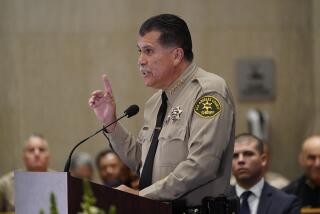Ban on Blythe Street Gangs May Go Too Far : Limited Injunctions Have Best Chance of Survival in Court
A Los Angeles City ordinance that seeks to ban members of a gang from the area on which they prey has thus far survived three relatively low-level legal challenges. It pertains to an area surrounding Blythe Street in Panorama City, in the geographical heart of the San Fernando Valley. It has been described both as the most crime-ridden stretch of the Valley, and as a neighborhood under siege by a gang that has played the role of an occupying army.
To combat this and to help reclaim the street for its law-abiding residents, the Los Angeles City Attorney’s office in April sought a 22-point court order barring gang members in a specific area around Blythe Street from engaging in otherwise legal activities. They would be barred from standing on rooftops and possessing pagers, cellular telephones or two-way radios. Those identified as gang members were also to be barred from carrying large flashlights, tools that could be used in car thefts, spray paint cans, etching devices, hammers, crowbars, gang logo belt buckles and other objects that might be used as weapons.
The city’s first victory came in Van Nuys Superior Court in April, when the American Civil Liberties Union, arguing as a friend of the court, failed to persuade a judge to block the ban. The second victory came in July, when a second Superior Court judge, Lloyd M. Nash, refused to dismiss charges against the first suspected gang member arrested under the temporary injunction.
The city’s third win came this past week, when the same alleged gang member was found guilty of violating the injunction in a case decided by Judge Nash. Jessie “Speedy” Gonzalez was found guilty of possessing a pager and a glass bottle, among other infractions.
But the larger and more important issue of whether the injunction violates constitutional protections remains unanswered, and on that, the city may be on very shaky ground. Judge Nash twice declined to rule on the constitutionality of the ban, which leaves that question open for consideration on appeal in this case, or in cases that will follow involving other suspected gang members.
In the past, we have looked favorably on gang bans that were briefly applied on streets and in public parks in San Fernando, Pomona and Burbank. But those bans were very limited in scope, were enforced in relatively small geographical areas, and were applied against relatively small groups whose members were so well known to the local authorities that they could nearly be identified on sight. Even then, we noted that the constitutionality of such bans was an issue that would be decided in the courts, and no previous case received a resilient challenge on constitutional grounds.
The Blythe Street ban is different in that it seeks to control a large gang (with 350 members), in an area involving more than 100 city blocks. The injunction also includes two gang curfew areas. It is unlikely that the LAPD can scour such a location--on the lookout for a gang larger than two Army companies--and not wind up confronting innocent citizens who only look like gang members.
We continue to believe that a more limited effort, targeting fewer individuals in a much smaller geographic area, would be more manageable, less labor intensive, and less likely to negatively impact innocent citizens. It might also be more likely to survive the spirited court challenge that will inevitably arise.
More to Read
Sign up for Essential California
The most important California stories and recommendations in your inbox every morning.
You may occasionally receive promotional content from the Los Angeles Times.










